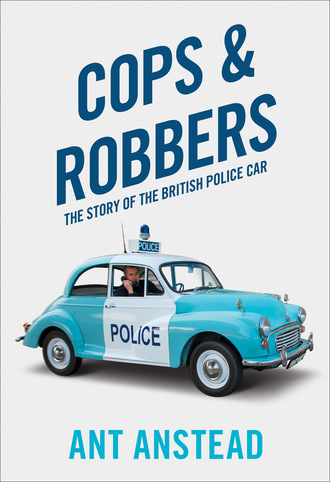
Полная версия
Cops and Robbers
World War I and the telegraph
World War I was the engine of much technological change, including wireless telegraphy, which used Morse code, and later what was then called radio telephony, which transmitted a voice. Both were refined and made more secure during the conflict, while radio communication took great leaps forward. Telegraphy was famously used by two-seater planes doing artillery observation (known as art-obs) above the trenches, where they tracked troop movements in order to improve the aim of their side’s own gunners if they were firing beyond the line of sight, by giving signals to the aimers to shoot slightly to one side, further or less far. This was a fluid operation, as wind conditions changed almost minute by minute, so having instant updates was important. The early planes in question had a long aerial hanging underneath them which was wound in and out on a drum so they did not drag it along when flying to and from the observation area. The industrial production of radio valves made telephony a practical proposition, however, and in 1916 the Royal Flying Corps started developing this, which meant that planes could tell ground stations where shells were landing by voice rather than coded message. In this embryonic stage this was a one-way signal; those manning the ground station would raise a flag to show they could hear. By 1918, the British had mastered plane-to-plane radio communication, which would have been unthinkable a few years earlier. After the war, this first generation of radio operators became the roots of the amateur radio movement, something that would lead to broadcast radio.
The first major police operation that was assisted by using radio telegraphy was the 1923 Epsom Derby, where the force used aircraft as well as the Crossleys for traffic control, not crime prevention. The Met arranged for the use of a radio-equipped Vickers (Type 61) Vulcan fixed-wing passenger aircraft to cover the Derby traffic. This bi-plane was unwieldy and under-powered; its single 360hp Rolls-Royce Eagle engine gave it a maximum speed of about 105mph, but it had restricted banking capabilities and very restrictive small windows so it was unsuitable for observation duties, especially over the confines of the Epsom Racecourse. It was, wonderfully, nicknamed the ‘Flying Pig’. The blue and silver Vulcan the police used, G-EBBL, was operated by Instone Airline Ltd and it carried the name ‘City of Antwerp’. The head of the Met’s Traffic Department, that man Arthur Bassom, was taken aloft along with two police wireless operators and their equipment by Donald Robins, the Instone pilot. The police team were in constant touch with Percy Laurie, who was in charge of the control room at Epsom, from where dispatch riders took instructions to traffic officers at the affected road junctions.
From these beginnings the radio technology developed quickly, and although we are not covering it in detail here, make no mistake, the organisation of police force cars into the categories of use discussed in the following chapters only happened because the police relied ever more on the improving radio technology.

CHAPTER FIVE
SEND THE AREA CAR
Operator: ‘Police emergency, how can I help?’ Caller: ‘A bloke’s going berserk with a knife down at the Rose and Crown.’ Operator: ‘OK, we’ll get a unit to you straight away.’ Operator: ‘Foxtrot five-one.’ Crew: ‘Foxtrot five-one go ahead.’ Operator: ‘Make the Rose and Crown pub in the High Street, male going berserk with a knife.’ Crew: ‘Foxtrot five-one making.’A typical ‘send the area car’ call. All over the country, every hour of every day, divisional area cars and their crews will be dispatched to attend local emergency calls just like that one. This was something I was all too familiar with during my time in the police force. The area car is the emergency response unit for each shift, the backbone of the force – the real front-line cops.
The divisional area car, or response car as some forces call them these days, will generally be a mid-range saloon or estate with a fair degree of performance. The aim is to get a double-crewed unit to the scene of any local emergency as quickly as possible. It’s worth noting at this point that your area-car officers are usually hand picked because they have a lot of front-line experience, are trusted to make life or death decisions, to take control of certain situations and have driving skills that are way above the average, having completed a four-week intensive driving course. Current-day models undertaking this role include the BMW 320d, Skoda Octavia vRS, Ford Mondeo 2.0d and the Vauxhall Insignia.
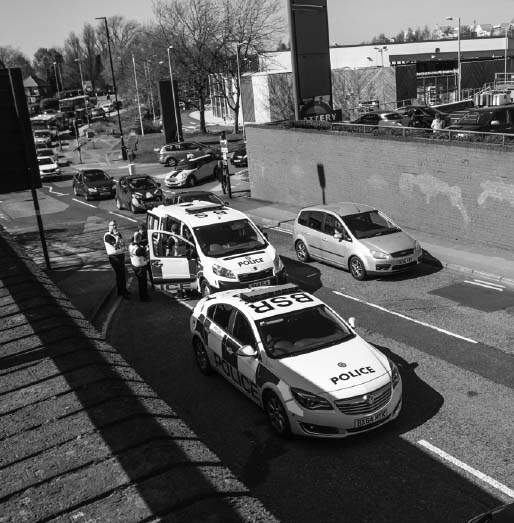
A Vauxhall Insignia area car deals with an RTA in Birmingham in 2016.
Unlike the panda car, whose introduction was down to one man and has a confirmed starting date, the origins of the area car are slightly more difficult to define. Nottingham Police may have been the first to have wireless cars in 1932. They used two-way wireless telegraphy (Morse), which was fully operational in vans, combos and single-manned cars. The method of operation was bizarre and would have gained them a £200 fixed penalty notice and six points on their licence today, whilst the health and safety people dived for cover to fill out their next claim form! Using his left hand, the driver would operate a Morse key on a large box where the passenger seat would normally have been fitted. He listened via an earpiece attached to his hat, whilst continuing to drive using his right hand! The Chief Constable of Nottingham in his 1940s book Mechanised Police Patrol refers to Radio Motor Patrols in an area scheme and in specimen exercises speaks of No.1 Area Patrol, No. 2 Area Patrol, etc., so it is likely that the term was eventually shortened to just Area.
The other early form of system came from the Metropolitan Police, who, in 1934, introduced the ‘Area Wireless Car Scheme’, whereby the Metropolitan Police District was divided into 75 wireless areas, each patrolled 24 hours a day by a radio-equipped car, manned by two uniformed officers in direct radio contact with the Information Room at Scotland Yard. Their mandate was to deal with all matters and incidents that required immediate police attention. The Met’s very first area wireless cars were Ford 14.9hp saloons, followed by Hillmans, Wolseleys and Humbers.

In 1937, Wolseley produced a special ‘police tourer’ version of the 14/56 chassis. It was not offered to civilian customers.
One of the earliest forms of area cars belonged to the Southampton Borough Police, who in 1956 devised a new concept in mobile policing that is still used today. Called Team Policing, it involved the use of Series 1 Hillman Minx estate cars, one being placed at each of the six sub-divisions within the Southampton Borough, and they were responsible for attending emergencies that fell outside of the remit of the Traffic Division. The cars were painted dark grey with a light grey roof and the only police markings consisted of a telltale roof-mounted radio aerial. To get through the traffic, crews would put the headlights on, and that would be enough in those days to ensure that the public would obligingly move out of their way! The team car experiment was a huge success; in later years the word ‘team’ was dropped and the term area car was adopted.
Unlike the panda car and indeed the Traffic Division cars, which were vehicles of a very specific type, the area car could be almost anything, depending on the force it belonged to and how it utilised the role. For example, in the 1960s the Cardiff City Police were using the Austin Cambridge A60 as an area car, whilst the Met Police used the much more powerful S-Type Jaguars, and by the late 1970s Kent County Police were sending their crews out in Morris Marina estates whilst the Met again gave their boys Rover 2.6 SD1s. We will concentrate on the most common cars, with perhaps an occasional oddity thrown in for good measure.
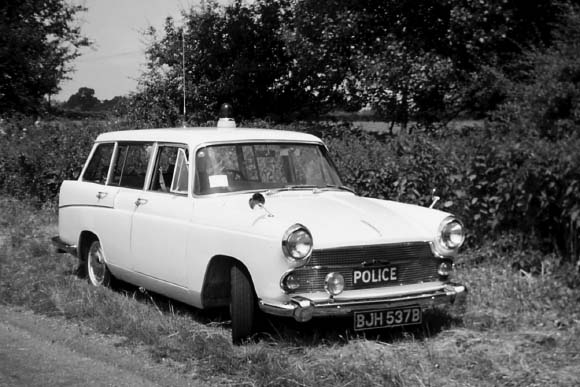
One of the big hitters in the 1960s was Austin and its Farina-bodied Cambridge. With its B-series 1622cc engine and 80mph top speed, it was used by a fair number of police forces as an area car. Although the Cambridge was an Austin design built and conceived at Longbridge, these cars were effectively the same model in five versions, because the Morris Oxford SeVI, Wolseley 16/60, MG Magnette MkIV and Riley 4/72 were basically the same cars with different lights, grilles, interior trim, or, in the case of the MG and Riley, more powerful 72bhp Twin Carburettor engine. The Austin was the cheapest of the range, which is one of the reasons why it was the most used by the police. BMC churned out around a million of these cars, in all badges, and they were used successfully. However, they were based on a floorplan and mechanical package, including all-round drum brakes, that went back to 1954 and by the mid-1960s were starting to be slow and under-geared for police work, which increasingly required more high-speed work, especially on the new urban dual carriageways that were starting to be built in this period.
The Austins did not catch on quite as much as had seemed likely, as the area car role was fulfilled by more modern designs such as the Mk2 Cortina. Why BMC never raided the corporate parts bin and updated this fundamentally sound if unexciting range by fitting the MGB’s 1800cc version of the same B-series and its matching overdrive gearbox is one of many missed opportunities in the complex world of BMC/BL history. Many members of the Cambridge-Oxford Owners Club, which is a thriving group of enthusiasts restoring these cars, have fitted MGB engines and gearboxes, which says it all really! (There was in fact a quasi-official attempt at this.)
It would be 15 years or so before another Austin product got the green light as a prospective candidate for area car use, with the Maestro and Montego both finding favour in several forces including the Met, Greater Manchester, Lancashire, Cumbria, Hertfordshire, Dorset and the West Midlands forces. They had adequate performance and a reasonable amount of room but suffered in the reliability department, like so many other British vehicles at this time. That said, let us not forget that the area car has an incredibly hard life; it’s on the road 24 hours a day, seven days a week, and gets caned by a variety of different officers during its relatively short but high-mileage police career. I certainly would not want to own an area car that my team and I had used …!

Hertford area car, Austin Montego 1.6.
Morris only ever produced one car that was used as an area car, but that didn’t stop it gaining legendary status; sadly, though, this was for all the wrong reasons. The Marina was virtually force-fed to the police by a government desperate to keep its ailing and by now state-owned car industry from total collapse, and by the mid-1970s several forces had been ‘persuaded’ to take them on, including Essex, Hertfordshire, South Wales, Cheshire, Hampshire, Thames Valley and the West Midlands. It wasn’t the fact that bits would fall off or its tendency to boil over at regular intervals that gave it its bad reputation, but more its legendary handling – or, rather, its complete lack of stability whilst negotiating anything resembling a curve in the road! It was quite simply appalling. Official complaints were made to senior officers that the cars were unsafe, with some officers refusing to drive them at all. Those unfortunate enough to crash one were hailed as heroes by their colleagues for managing to get rid of the car! The photo shown here comes from the Hampshire Constabulary and is an official photograph taken to show how bad the car was. It is a 1.8TC saloon negotiating an average-sized roundabout at less than 20mph with massive understeer and a suspension set-up that induced motion sickness.
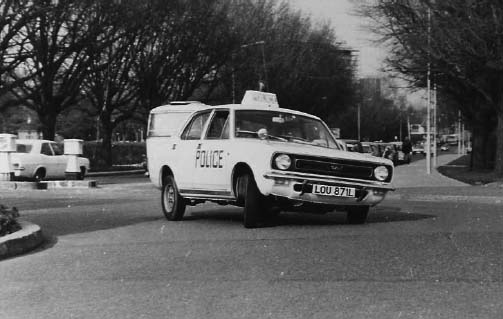
Ford has made more cars that are suited to the role of area car than just about all the other manufacturers put together, thanks largely to the Cortina. The original Mk1 wasn’t particularly popular, with only Wakefield City, Surrey and Bedfordshire Police experimenting with them. But in Mk2 guise it received far more attention, especially in 1600 GT form. The car was good for 100mph, with decent handling and a fair degree of street cred to go with it. Essex Police, Devon and Cornwall, Cumbria, Merseyside and Hampshire all bought Mk2s for area car duties. The Mk3 Cortina was just as popular, although its 1970s build quality left much to be desired. As a police car it looked terrific, and several forces even used the estate variant as an area car, including the Devon and Cornwall Police and the Lancashire Constabulary, who painted theirs bright orange. Mk3 saloons were used by Kent, Surrey, Hampshire, Lancashire, Thames Valley and South Yorkshire Police, with most opting to use the 2000 GT model. But these were no ordinary versions, oh no – in order to keep the price to a minimum the plush GT seats with their integrated head rests were replaced with the standard 1300L seats with no head rests or back adjustment, the carpets were replaced with a rubber matting and most of the other interior GT fitments were also missing!
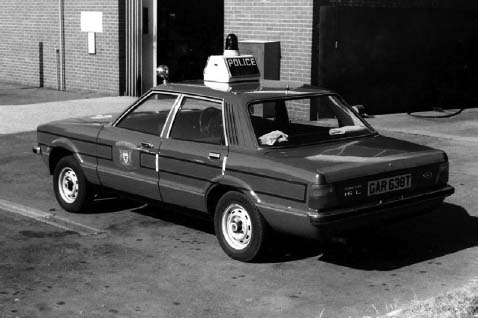
In 1976, with the launch of the Mk4, the Cortina had become a firm favourite as a company rep-mobile and found more police customers, including the City of London, Essex, North Wales, Cumbria, Dyfed-Powys, West Yorkshire, Hertfordshire, Hampshire and Thames Valley Police. In 2.0S trim it came with the excellent 2.0-litre Pinto engine married to a slick and very precise 4-speed manual gearbox. It also got an all-black interior and black treatment to the window frames and bumpers, giving it a rather mean look. By the early 1980s the Mk4 had got some slight cosmetic updates and became the Mk5, but few forces seemed interested as other cars were starting to make a dent on Ford’s monopoly.
Along the way there were a few Ford oddities thrown in, such as the Mk3 Zephyr 4 from the mid-1960s, whilst in the 70s quite a few forces used the Consul GT and later the Mk1 Granada, including the fabulous 3.0S. The Granada was one of the few cars that managed to fulfil both traffic and area car roles. It was a large car with a good strong engine and excellent road holding for its size, although manoeuvring the thing at low speeds without power steering took some doing. Even the Ford Corsair got a look-in with a couple of forces, including Cheshire, Wiltshire, Somerset and Bath Constabulary and the Wolverhampton Borough Police. The Ford Orion saw service with Hertfordshire and Devon and Cornwall Police.
In the early 1980s Ford gave us the ‘jelly mould’, otherwise known as the Ford Sierra, in both hatchback, saloon and estate variants, and it was a very popular choice for area car services in virtually every force in the country. Here was a medium-sized car made available with a number of engine options from 1.6, 2.0 and 2.3 litre that the police could choose from, and they bought them by the bucket load. The car even starred in that new TV series of the era, The Bill, and was an integral part of the opening credits, with PC Alan Stamp, the Relief Area Car driver, behind the wheel.
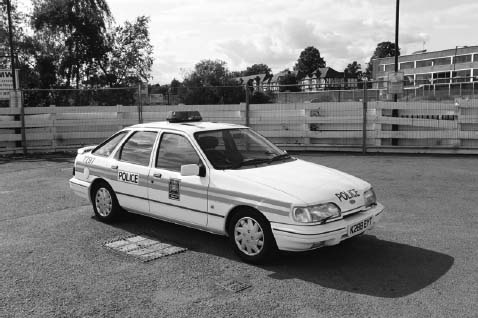
In automotive terms, the Sierra was quite short-lived, being replaced by the first series Mondeo in 1990. Even though the cars were pretty similar in size and specification, the Mondeo was nowhere near as popular in police use. As the car morphed into the Mk2 Mondeo things did improve slightly, but by the mid-1990s there were huge changes taking place with the advent of common rail diesel engines being pioneered by BMW and Peugeot, which had Ford and every other manufacturer playing catch-up. It was over a decade before Ford could fight back with the Mk3 Focus that a lot of forces opted to take on in an era where costs were playing a significant role once again. At this stage, it’s worth noting that just changing a car is only the tip of the police car iceberg. Before that decision is taken, the car has to be thoroughly tested to assess its suitability for the role, then the workshops have to be kitted out with all the latest computer software applicable to that make and model; specialist tools would often need to be purchased, and in some cases technicians were sent off to the manufacturers’ training establishment to undertake courses to learn about the latest technology involved. However, at the end of the day, if the bean counters upstairs didn’t like the figures there would be a sharp intake of breath through gritted teeth as they stated rather firmly that they didn’t think the car was ‘best value’. So in twenty-first-century Britain you’ll find a huge number of Ford Focus area cars in your neighbourhood, although you might find it nigh on impossible to decipher which is the section car (current term for panda car!) and which is the area car, as they will both look identical, dressed in their modern Battenburg clothes.
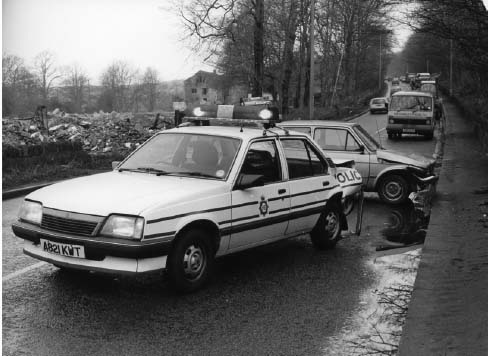
Yorkshire Mk2 Cavalier after being involved in an RTA.
Vauxhall’s area car contribution in the 1960s included the Victor FC with its 1600cc engine, which was similar in styling to the later Mk3 Cortina but not as popular with either the public or the police. Most of Vauxhall’s other models were either the bigger-engined Traffic cars or the panda car range, with little in between. It wasn’t until the advent of the front-wheel-drive Mk2 Cavalier that Vauxhall produced a car that would be able to cut it as an area car. The Cavalier was a good, strong workhorse made available as a saloon and a hatchback with a willing engine that produced reasonable performance, and, like the Cortina, it soon found its niche as a response vehicle. Merseyside, Derbyshire and Sussex Police took on the Cavalier, and, in later Mk3 and Mk4 versions, forces like the Met and Lancashire also brought them on board. But just like Ford in the mid-1990s, Vauxhall were caught napping and missed the move towards diesel power, and it was several years before we started to see cars like the Mk2 Vectra and the Mk5 Astra make a fight back towards the lucrative police market.
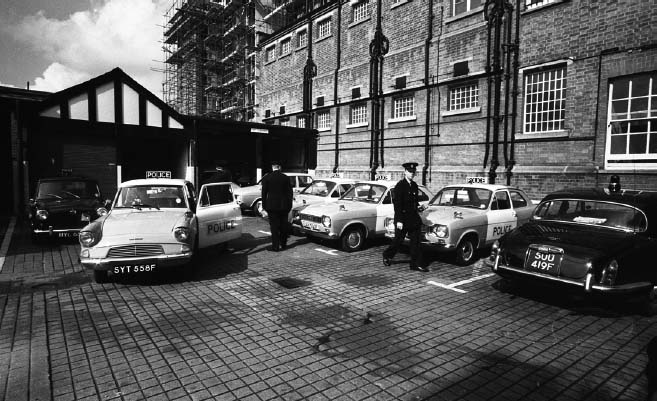
This picture of Woolwich Police Station yard in 1968 shows the eras changing, new Escort panda cars coming in to replace Anglias, but an S-type area car still being used along with a Hunter, Rover P4 and Mk2 Cortina.
Think Jaguar and most of us will think Traffic car; whether it be a 1960s Mk2 or the latter XJ6 range, we generally remember the big cats for cruising the country’s motorway network. But the Metropolitan Police decided that the S-Type Jaguar would make an ideal area car – and who would possibly argue? Certainly not the boys tasked with driving them! Probably one of the best-looking saloon cars of all time, the S-Type Jaguar still stirs something in most of us, and in police trim it looks positively fabulous. The Met employed these cars as both traffic and area cars, with the former painted in white and the latter in black. These cars were produced on a separate production line – but only at the weekends – and were some 33 per cent cheaper to buy than the standard production car, but then there were some significant changes to facilitate that reduction that makes these cars unique. For starters, the 3.4-litre engine was changed in favour of the more powerful 3.8 unit, which was married to an automatic gearbox and a low-ratio Power-Lok limited-slip differential. There was no power-assisted steering and the tachometer was removed. But it was the interior where most of the savings were made, by removing the polished walnut veneer dash and door cappings so often associated with the marque and replacing them with very cheap wood painted matt black. Out came the deep-pile carpet and in went rubber floor matting. The door cards were plain black vinyl affairs with no door pockets or arm rests. In total there were more than 150 changes made to each car, and between 1966 and 1968 the Met Police bought 266 S-Type Jags, making it the single-biggest order for one model ever made. Of those 266 units, 183 of them were black area cars whilst the remaining 83 white cars were designated as Traffic cars. It must have been quite a thrill to drive one, on a shout with the Winkworth bell chiming away through the streets of 1960s London, although it’s doubtful whether it was possible to get anywhere near the car’s 120mph top end very often. A total of only five police-spec S-Type Jaguars have been saved and restored to their former glory, with three of them being area cars. As a restorer, personally I think it’s a shame that more of these cars were not saved.
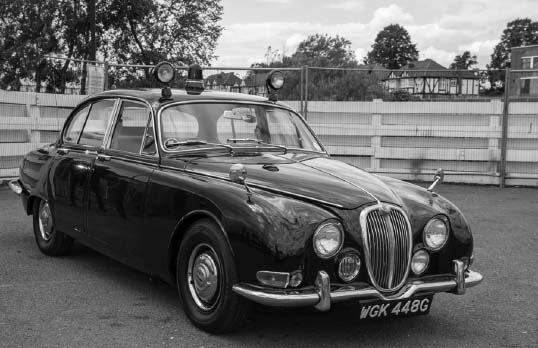
Prior to the Met buying S-Type Jags, their area car of choice was the Wolseley 6/110. The big Farina cars were powered by a 2.9-litre straight six engine mated to a 3-speed gearbox. They were all finished in black and carried a large PA speaker on the roof. The cars were good for just over 100mph and the officers who crewed them rated them as the best area cars they’d ever had. In most other forces the cars were used as Traffic cars, with the last ones still in service as late as 1972. Their subsequent success on the banger racing circuit (big BMC Farinas were the banger of choice in the 70s and 80s) oddly required much the same qualities as those needed in a police car. Shame so many got destroyed, though.
Rover’s foray into the police-car market didn’t really begin until the introduction of the P6, but with it came instant cult status. Prior to the P6’s introduction a couple of forces had dabbled with the P4 – namely Cheshire, who had an entire fleet of them in green! Like the Wolseley 6/80 and the Jaguar Mk2, the Rover has become an iconic police vehicle revered by many, especially those officers who were tasked with driving them. Although many forces used the 3500 V8 as a Traffic car, with some using the smaller 2200 as an area car, only the Met sought to use the V8 as an area car, taking over the role from the outgoing S-Type Jags. They were all finished in Zircon blue, with a single blue light and a couple of Mickey Mouse spot lamps adorning the roof, and they will no doubt be remembered by Londoners of a certain age. You know who you are …



